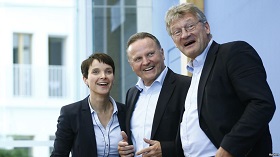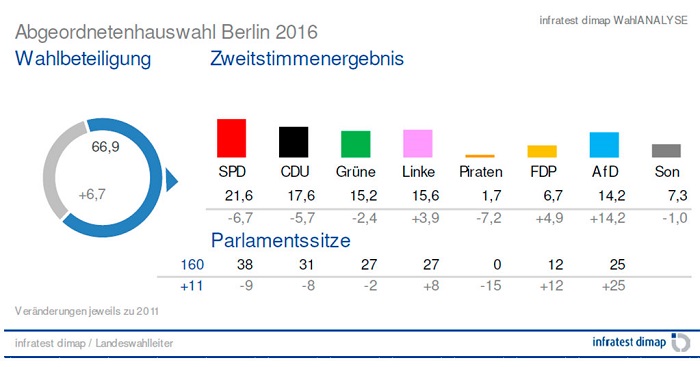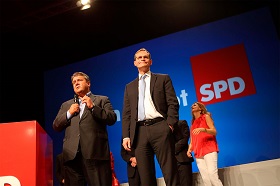Berlin Elections: A Victory for the Protest Parties
German Chancellor and chairwomen
of the Christian Democratic Union Angela Merkel
and top candidate for the Berlin city-state
elections Frank Henkel leave a news conference
in Berlin, Germany, September 19, 2016
In
Login if you are already registered
(no votes) |
(0 votes) |
Ph.D in Economics, Deputy Director of the RAS Institute for Europe, Head of the Country and Regional Researches Department, Head of the German Research Center
The Berlin state election – the fifth and final election of the calendar year in Germany – was held on September 18. In terms of party-political processes, the results are particularly intriguing, especially given the upcoming elections to the lower house of the German parliament (the Bundestag) to be held later this month.
The Berlin state election – the fifth and final election of the calendar year in Germany – was held on September 18. In terms of party-political processes, the results are particularly intriguing, especially given the upcoming elections to the lower house of the German parliament (the Bundestag) to be held later this month.
Main Results
The Social Democratic Party of Germany won the majority of the votes (21.6 %, down by 6.7 % from 2011), followed by the Christian Democratic Union of Germany (17.6 %, down 5.7 %) in second. The Left finished third with 15.6 per cent of the votes (up 3.9 %), in front of Alliance ’90/The Greens (15.2 %, down 2.4 %) in fourth, the Alternative for Germany (14.2 %, up 14.2 %) in fifth, and the Free Democratic Party (6.7 %, up 4.9 %) in sixth. The Pirate Party won just 1.7 per cent of the votes (down 7.2 %), meaning that it will not have seat in parliament.
The Pirate Party was thus the biggest loser in the election, giving up 15 seats, followed by the ruling Social Democratic Party (nine seats), the Christian Democratic Union (eight seats), and Alliance ’90/The Greens (two seats). The Alternative for Germany party won the most new seats (25), with the Free Democratic Party coming in second (12 seats) and the Left third (eight seats). It is these three parties that can call the election a success.
Voter turnout at the election increased by 6.7 per cent (to 66.9 %) from 2011. In numerical terms, this amounts to 1.663 million people voting (out of 2.485 million eligible), the highest turnout since 2001. The number of people who did not vote went down by 160,000 (to 823,000).
Now, for the first time ever, there will be six parties represented in parliament, rather than the usual five. In order to form a functioning coalition, an agreement needs to be reached by at least three of the parties.
Now, for the first time ever, there will be six parties represented in parliament, rather than the usual five.
The Voting Preferences of Berliners
The Christian Democratic Union and the Social Democratic Party lost the majority of their voters to the “Alternatives,” which, much like in the state of Mecklenburg-Vorpommern, enjoyed the support of the so-called “non-voting” citizen (about one quarter of all votes). The main motivating factor behind voters turning to the Alternative for Germany was dissatisfaction with the country’s immigration policy of the red-black coalition. In both cases, this was a result of the poorly received economic policies.
Just like the Social Democrats, the Christian Democratic Union received a record-low number of votes in terms of overall percentage.
It is worth noting that the red-black government has achieved considerable success over the past five years. Berlin ranks third among the 16 German federal states in terms of average gross regional product (for 2011–2016), and third in terms of lowering unemployment. In the run-up to the election, 62 per cent of Berliners rated the economic situation in the capital as either “good” or “very good.” The main source of displeasure was connected to the actual people in the Senate of Berlin. This, despite the fact that Mayor of Berlin Michael Müller enjoyed an approval rating of 53 %. The Social Democrat leader is far more popular among the people of Berlin than his main political rival, the Christian Democratic Union representative Frank Henkel, particularly in terms of likability, trustworthiness and his skills and competencies as a leader. According to the pre-election polls, 57 per cent of Berliners wanted to see Müller continue in his role as Mayor, with respondents believing the Social Democratic Party would be the best choice when it comes to creating jobs and keeping people in work (35 %), social justice issues (31 %), family policy, housing, integration and education. As for economics and security, 30 per cent and 25 per cent of respondents put their faith in the Social Democratic Party.
The Greens have lost ground as a result of people voting for the Left and the Free Democratic Party.
The main priority for the supporters of the Social Democrats (the party is particularly popular among those aged 60 and over, as well as the poorly educated, the self-employed and people working in the services industry, while it has mainly lost the blue-collar workers and the unemployed) is social justice, followed by economic and education policies.
The Christian Democrats suffered losses in all age demographics (primarily among the younger voters and the elderly), as well as service industry workers and the self-employed, for which Frank Henkel is largely to blame. At the same time, the party became more popular among the unemployed. The foundation of the Christian Democratic Union’s support is made up of service industry workers, pensioners and the poorly educated. Just like the Social Democrats, the Christian Democratic Union received a record-low number of votes in terms of overall percentage. The most important issues for the party include economic development, the situation on the labour market, domestic security, social justice and education.

Berlin top candidate of the
anti-immigration party Alternative for Germany
(AfD) Georg Pazderski and AfD Germany
co-leaders Joerg Meuthen and Frauke Petri.
The Greens have lost ground as a result of people voting for the Left and the Free Democratic Party, primarily service industry workers, the 35–59 age demographic and people with a higher education. The party is particularly unpopular among the elderly (60 years and older), the poorly educated, blue-collar workers and the unemployed. Its main source of support is the self-employed. The most important issues for the party’s supporters include social justice, energy, and policies related to primary, secondary and higher education. It is worth noting that the Greens pre-election campaign in Berlin was rather dull and uninteresting, and so were its four main candidates.
The Left caused a sensation by gaining seats in parliament, which it achieved in part by securing a significant portion of the votes that would have gone to the Pirate Party, the Greens and the Social Democratic Party. At the same time, like other parties, it lost a number of votes to the Alternative for Germany party. The Left is popular among all age groups, but especially among younger voters, the middle-aged, service industry workers and people with a higher education. Its core issues include social justice, rent issues, and economic and education policies. It is important that there was no so-called Ostalgie (nostalgia for the socialist past) this time around.
There was no so-called Ostalgie (nostalgia for the socialist past) this time around.
The Free Democratic Party was able to snatch voters away from the Christian Democratic Union, the Social Democratic Party and the Greens, although some of its supporters did switch to the Alternative for Germany. The party relies on the votes of all age groups, but especially on the older generation. It is popular among the self-employed, pensioners and people with a higher education, fuelled by protest movements and a dissatisfaction with the ruling coalition. The party’s primary interests include economics and education. It was also able to use the Tegel Airport situation to its advantage.
The Alternative for Germany successfully took votes away from the Christian Democratic Union, the Social Democratic Party, the Lefts and the Pirate Party. However, the majority of its votes came from the “non-voters” and the supporters of other parties. The bulk of the party’s electorate is made up of blue-collar workers, the unemployed, males aged 45 to 59, the poorly educated (college and high-school level) and people who are dissatisfied with their economic situation. Two-thirds of those who voted for the Alternative for Germany party did so as a protest vote – as a sign of dissatisfaction with the policies of the remaining parties, particularly with regard to immigration – while about one quarter of its votes came from long-time supporters. The most important problems for the party include the migrant issue, domestic security and social justice, and it used a number of populist slogans during the pre-election campaign, which was successfully led by the leader of the party in Berlin, Georg Pazderski.
What Coalitions are Possible?
The most important problems for the party include the migrant issue, domestic security and social justice, and it used a number of populist slogans during the pre-election campaign.
Immediately after the elections it became clear that the former red-black coalition (between the Social Democratic Party and the Christian Democratic Union) would not survive, and that the Social Democrats would open negotiations with other parties. The most likely coalition is between the Social Democrats on the one hand, the Left and the Greens on the other. And it is not only the supporters of the Social Democratic Party who believe that this is the best option, as the majority of Berliners are in agreement on the issue. Other possible, and acceptable, combinations include: the Social Democratic Party, the Greens and the Free Democratic Party; and the Social Democratic Party, the Christian Democratic Union and the Free Democratic Party, although both are unlikely.
In the week following the election, Mayor Müller held talks with possible coalition partners. His meeting with the leader of the Christian Democratic Union, Frank Henkel, resulted in both sides agreeing that their existing coalition was no longer tenable – although both politicians stressed their satisfaction with the results they had been able achieve.
Immediately after the elections it became clear that the former red-black coalition (between the Social Democratic Party and the Christian Democratic Union) would not survive, and that the Social Democrats would open negotiations with other parties.
Müller also had negotiations with the Left (led by Klaus Lederer), the Greens (Ramona Pop) and the Free Democrats (Sebastian Chaya). The Left and the Greens expressed a willingness after the elections to be part of a red-red-green coalition led by the Social Democratic Party, pointing to the positive experience of cooperation with the Social Democrats in other federal states. This is the most likely outcome. However, the most effective government will largely depend on the ability of the sides to find a common denominator. It is common knowledge that they are many issues of contention among the parties.
Significance of the Berlin Election for Merkel
The defeat of the Christian Democratic Union at the two previous state elections came as a serious blow to the image of Angela Merkel, the leader of the party and the current Chancellor of Germany. Experts had originally predicted that the Christian Democrats would lose votes, and that the Alternative for Germany would be successful, and opinion polls supported their forecasts. This notwithstanding, the media wrote about the results as if they were a sensation, focusing exclusively on the Federal Chancellor and her failed migration policy, which stands behind the defeat of the Christian Democratic Union.
As party leader and head of the coalition, Merkel acknowledged her responsibility for the unsatisfactory results of the Berlin election at a news conference on Monday, September 19, 2016. Moreover, she admitted that the German state had been unprepared for the migration crisis of 2015 and her famous “We can do it!” slogan had no real substance and was only a portion of her political work. At the same time, she appreciated the measures the government took in 2016 (including at the level of the National Integration Plan under the motto “Support and Demand”), which are being implemented now and are expected to have increasingly positive results in the near future.
The defeat of the Christian Democratic Union at the two previous state elections came as a serious blow to the image of Angela Merkel, the leader of the party and the current Chancellor of Germany.
The self-criticism of the Chancellor was lauded by the Christian Social Union, which had slammed Merkel over the past few weeks for her unwillingness to seek compromise in the migration issue. Despite the fact that she declined to answer the question about her attitude to setting quantitative restrictions or an upper limit for refugees, the Bavarian partners chose to change their tonality and get back to a constructive dialogue on the state migration policy. In other words, Merkel managed to reap benefits even from the negativity of the election. Moreover, the question mark still remains regarding her political career in 2017, when the election is scheduled to be staged.
***
The Berlin state election of 2016 showed that neither the Social Democratic Party nor the Christian Democratic Union have yet recovered from the crisis. They are currently unable to offer any exciting slogans or convincing solutions to existing challenges. They are losing members and voters, who express their protest by supporting smaller parties. Despite the apparent success of the black-red coalition in Berlin, electors are looking at both parties through the federal prism, refusing to trust its state leaders.
The Berlin state election of 2016 showed that neither the Social Democratic Party nor the Christian Democratic Union have yet recovered from the crisis.
Both parties will have to redouble their efforts in the months to come in order to restore their electoral support. This is what the two leaders, Merkel and Sigmar Gabriel, will need to focus on. As of today, the two are the most probable candidates for the position of Federal Chancellor at the upcoming 2017 Bundestag election.
The trend outlined in Berlin (the election of a six-party parliament) will quite likely be repeated at the federal election of 2017, when for the first time ever, the lower house will have representatives of seven parties. A situation will emerge when there will be various three-party coalition options. One of them might as well be red-red-green – this will largely depend on the success of the same government pattern in Berlin.
Merkel and Sigmar Gabriel, as of today, the two are the most probable candidates for the position of Federal Chancellor at the upcoming 2017 Bundestag election.
In 2017, elections will be held in North Rhine-Westphalia (the largest state in Germany), Schleswig-Holstein and Saarland. They will become a test showing the sentiment of the German electorate. It will also be clear, among others, to what extent the Alternative for Germany will manage to isolate itself from right-radical moods in the party and respective image.
By that time, it will also become apparent whether its representatives in state parliaments and district municipal councils are capable of constructive engagement with their political colleagues. At the same time, the implementation of the national integration plan for refugees (whose flows will be decreasing) will showing increasing results, which will narrow the room for populism at the Alternative for Germany, for its leaders must have learnt the lesson of the Pirate Party, which has virtually become history. The Alternative for Germany will have to compete with other established parties over the entire range of German internal and external policies. Naturally, the same applies to the Left and the Greens, but especially to free democrats, who wish to return to the federal political field.
(no votes) |
(0 votes) |






